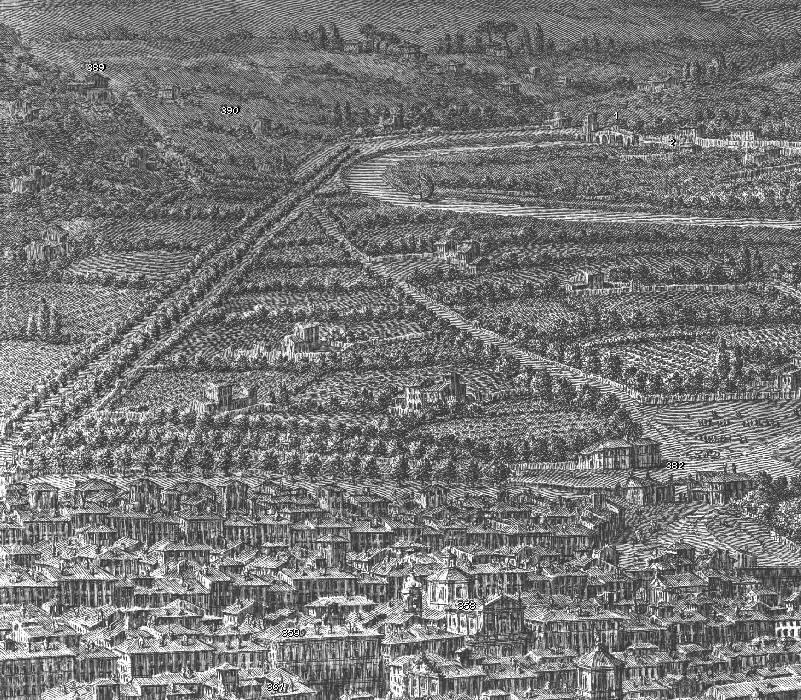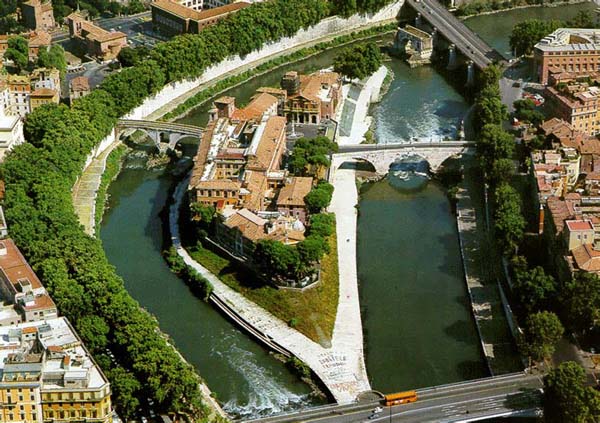
The BORGO, the district on the right
bank of the Tiber between the Janiculum to the south and Monte Mario to
the north, was known in ancient Rome as Ager Vaticanus (Vatican field).
It was the stronghold of the papacy from 850, when Leo IV surrounded it
with a line of walls, until 1586, when it was formally incorporated in
the city of Rome.
The Ager Vaticanus was chosen by Caligula
(37-41 AD ) for his circus, which was enlarged by Nero (54 68). The site
of the Circus of Nero, just south of the Basilica of St. Peter's, was identified
during excavations in the 20th century. In the adjoining gardens many Christians
were martyred under Nero in 65 AD, including St. Peter who was buried in
a pagan cemetery nearby. Over his grave the first church of St. Peter's
was built (ca. 90 AD ) to commemorate his martyrdom. Also within the Ager
Vaticanus, Hadrian built his mausoleum (now Castel Sant'Angelo) in 135
AD .
Some sources say that the Borgo was
founded as a separate residential community in the 6th century by Totila,
King of the Goths, but archeological evidence does not agree. Inscriptions
found in temples of Cybele and Mithras suggest that Roman pagan communities
preexisted and that paganism retained its hold in the area until the late
4th century. Meanwhile, Christians were moving into the area:
churches, chapels and convents were built round the first church of St.
Peter, and the district, which attracted Saxon, Frank and Lombard pilgrims,
came to be called the Borgo (borough), a name of Germanic origin from borgus
meaning a small fortified settlement. Most authorities agree that
the name originally was applied to the Borgus Saxonum founded by
King Ine of Wessex, who abdicated his throne and came to live in Rome in
726 AD. That borgus stood at the site of the present Arciospedale
di Santo Spirito in Sassia on the street now named Borgo S. Spirito.
Other such communities followed. (The ospedaletto next door
to S. Spirito [built by Sixtus IV from 1473-78] has a museum of the history
of medicine starting with ancient Roman times and the Palazzo del Commendatore,
the historic residence of the hospital director, further on [built 1567-71],
has a corresponding medical history library, the Biblioteca Lancisiana.)
In 850 Leo IV (847-55) built 12 meter
high walls around the Borgo, fortified with circular towers, to protect
the neighborhood from the incursions of the Saracens: Since then, the area
has also been known as the Leonine City (Citta Leonina). Remnants
of Leo's wall survive to the west of St. Peter's. The Leonine City became
the papal citadel: within its walls John VIII was besieged in 878 by the
Duke of Spoleto; in 896 Arnulph of Carinthia attacked it and Formosus crowned
him emperor. Gregory VII took refuge in the Castel Sant'Angelo from the
Emperor Henry, and was rescued by Robert Guiscard in 1084. After the coronation
in 1167 of Barbarossa in St. Peter's, the Romans besieged the Leonine City
(and attacked it again 12 years later).
During the "Babylonian captivity" (1309-78)
the Borgo fell into ruin, but when the popes returned from Avignon to Rome
they chose the Vatican as their residence in place of the Lateran. In the
15th century Eugenius IV and Sixtus IV, and early in the 16th century Julius
II and Leo X were active in developing and embellishing the Borgo as well
as the Vatican. The original area of the Borgo was enlarged to the north
of Borgo Angelico. However, after the sack of Rome in 1527 the Borgo became
one of the poorest and least populated districts of Rome, and in 1586 Sixtus
V relinquished the papal claim to this area, so that it was united to the
city of Rome.
Five (originally seven) streets in the
Leonine City have the prefix Borgo. Borgo Sant'Angelo and Borgo Santo Spirito
run respectively north and south of Via della Conciliazione. In the construction
of that street, the central Borghi, Nuovo and Vecchio, were destroyed along
with the narrow strip of buildings between them, the spina, so named
because of its resemblance to the spina of classical circuses. Via
della Concilazione was built between (1936 to 1949) to celebrate the reconciliation
of the Papacy and the Italian state achieved by the Lateran Treaty of 1929.
The remaining Borgo streets, the Borghi Angelico, Vittorio, and Pio survive
north of Borgo Sant'Angelo, between the Castel Sant'Angelo and the Vatican.
The passetto, a raised fortified
corridor emerges from the palace behind the northern wing of the great
elliptical colonnade around St. Peter's Square and runs along Via dei Corridori
and Borgo Sant'Angelo to Castel Sant'Angelo. Sources disagree on
when and by whom the passetto was constructed: either by Pope
Nicholas II in 1277 or by the anti Pope John XXIII (1410-15). Pope
Alexander VI Borgia repaired the passetto late in the 15th Century.
On some maps it is shown as the Corridore di Alessandro VI. In 1527,
Pope Clement VII used this escape route to Castel Sant'Angelo during the
sack of Rome.
The famous Ponte Sant'Angelo (pedestrians
only), the ancient Pons Aelius or Pons Adrianus, was built by Emperor Hadrian
(Publius Aelius Hadrianus) in 134 as a fitting approach from the Campus
Martius to his mausoleum, known since the Middle Ages as the Castel Sant'Angelo.
Although the Roman bridge was decorated with statues, it was transformed
by Gian Lorenzo Bernini when he designed the ten statues on the balustrade
of angels holding the symbols of the Passion. These were executed in 1688
by his pupils, including Ercole Ferrata, Pietro Paolo Naldini, Cosimo Fancelli,
and Antonio Raggi; two of the angels are copies of the originals which
were removed to the church of Sant'Andrea delle Fratte. At the end towards
the castle, the statues of St. Peter and Paul, by the school of Lorenzetto
and Paolo Taccone (1464), were set up by Clement VII in 1534. The three
central arches are part of the original structure; the end arches were
restored and enlarged in 1892-94 during the construction of the lungotevere
embankments.
To the south of Ponte Sant'Angelo is
Ponte Vittorio Emanuele (1911), decorated with monumental sculptures in
travertine, and bronze victories.
Raphael's
The
Fire in the Borgo -- Vatican Stanzae (image)
The Districts
of Rome - Rione Borgo
Mausoleum
of Hadrian/Castel Sant'Angelo
S.
Pietro
The Citta-Giardino Aniene, also designed by Gustavo Giovannoni, if well
documented on the internet.

